- Home
- Resurrection ▾
-
Learn ▾
- Free library
- Glossary
- Documents
- Initiation
-
Shaped fabrics
- Introduction
- Popularization
- Definitions
- Le métier de façonné
- Principes du façonné
- Mécaniques de façonné
- Le jeu des crochets
- Les cartons
- Chaîne des cartons
- Mécanique 104 en détail
- Pour en finir
- Montage façonné
- Empoutage 1/3
- Empoutage 2/3
- Empoutage 3/3
- Punching, hanging and dip
- Autres façonnés
- Façonnés et Islam
-
Cours de tissage 1912
- Bâti d'un métier
- Le rouleau arrière
- Les bascules
- Formation du pas
- Position de organes
- Mécanique 104 Jacquard
- Fonctionnement 104
- Lisage des cartons
- Le battant du métier
- Le régulateur
- Réduction et régulateur
- Mise au métier d'une chaîne
- Mise en route du métier
- Navettes à soie
- Battage
- Ourdissage mécanique
- Préparation chaînes et trames
- Equipment ▾
- Chronicles ▾
- Fabrics ▾
- Techniques ▾
- Culture ▾
- Language ▾
Twisting operation 6/6
2 / - flap of the twist thus created on the wire of the new chain by roller Of the thumb on the index to the joinBetween the second and third phalanges.
It is important that these two movements of torsion are connected frankly and without hesitation. Before, the 3 fingers will have been soaked in white of Troyes.(Pasty mixture of chalk powder and petroleum jelly oil).
An experimented leafroller produces an average of 1200 to 1400 twists per hour.
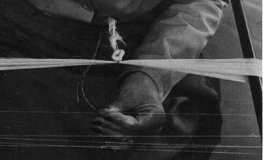
Twisting operation 5/6
Always using the thumb and forefinger, the 2 wires are twistedTogether in a double operation:
1 / - torsion of the two threads by rolling of the indexOn the thumb to the joint between the firstAnd the second phalanx of the thumb.
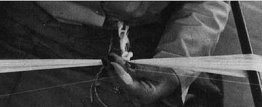
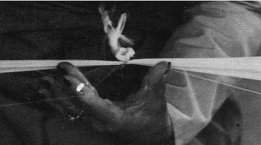
Twisting operation 4/6
With the thumb and forefinger of the left hand, the two threads are brought togetherThen plucked, while the major breaks under the two threads to theLevel of the node of the cord.
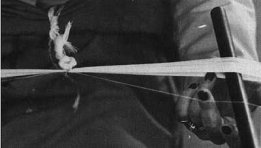
Twisting operation 3/6With the left hand and the right hand, she selects theNext twists in the sticks.
Twisting operation 2/6
With the aid of a cord, she unites the two packages of threads together.The other end of the cord is tied at the waist so as to be very tight.
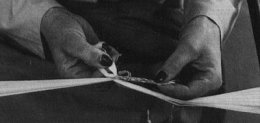
Twisting operation 1/6
The budworm intersects the nodes of the chain bets: on the left the betting of the new string, on the right that of the chain that is finished.
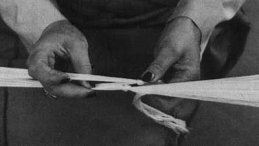
Twist
Knotting, with an electric knot, is used for large yarns and double yarns. An automatic knot machine will be used with great advantage. The speed of the machine is about 200 knots per minute, but requires adjustment and perfect operation ...
We have practiced only the old method of twisting silk.
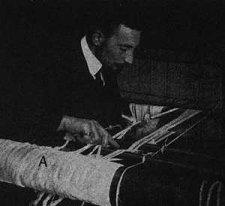
For twisting, the two ends of wire are rolled between the fingers, coated with a little Spanish white, milk, water, gum or sugar, ash, and the like. We use personally white Troyes (crushed chalk mixed with vaseline). This twisting is done in such a way that the twist or brown part falls down on the side of the rear roll (beam), otherwise it would be impossible to pass it through the link and into the tooth of the comb without the " untwist ". The leafroller will attach the bundles of wires two by two to the belt with a coder (so that the two strands are taut), one coming from the back roll and the other from the shed of frames. It will take the threads as they present themselves on both sides on the canes (rods) of wingspan and will join them by twists. So that her fingers do not slip, she plunges them into the white of Troyes (thumb, forefinger and major).
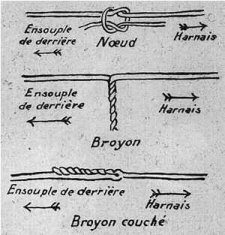
The Twist
When we weave a new chain similar to the one we have just finished (new color for example) and using the same shed (harness or set of frames), we avoid the long and tedious operation of remounting (Drawing) and that of the comb stitching by twisting or knotting. The threads of the finishing chain are joined one by one to those of the new weaving chain, either by twisting (brown or twisted) or by knotting (knot), depending on the material and its size.